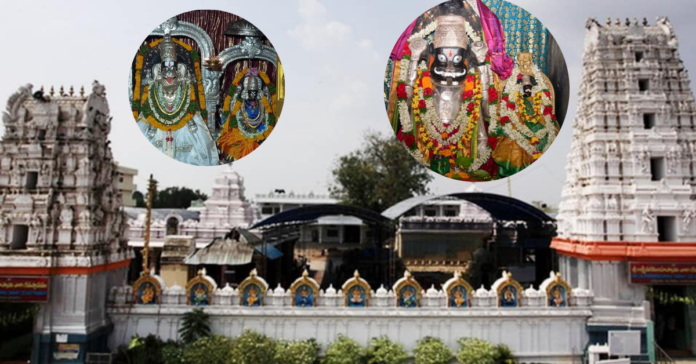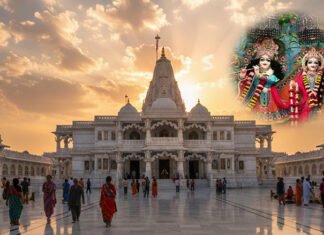Introduction
The Dharmapuri Lakshmi Narasimha Swamy Temple, nestled in the serene village of Dharmapuri in Telangana’s Jagtial district, is a majestic embodiment of South Indian spiritual and architectural heritage. Revered for centuries, this ancient shrine dedicated to Lord Narasimha, an incarnation of Lord Vishnu, holds a prominent place in the hearts of devotees. This extensive guide will delve into the temple’s history, significance, main deities, festivals, rituals, and the unique role of Yama Dharmaraja, providing a detailed exploration of this sacred site.
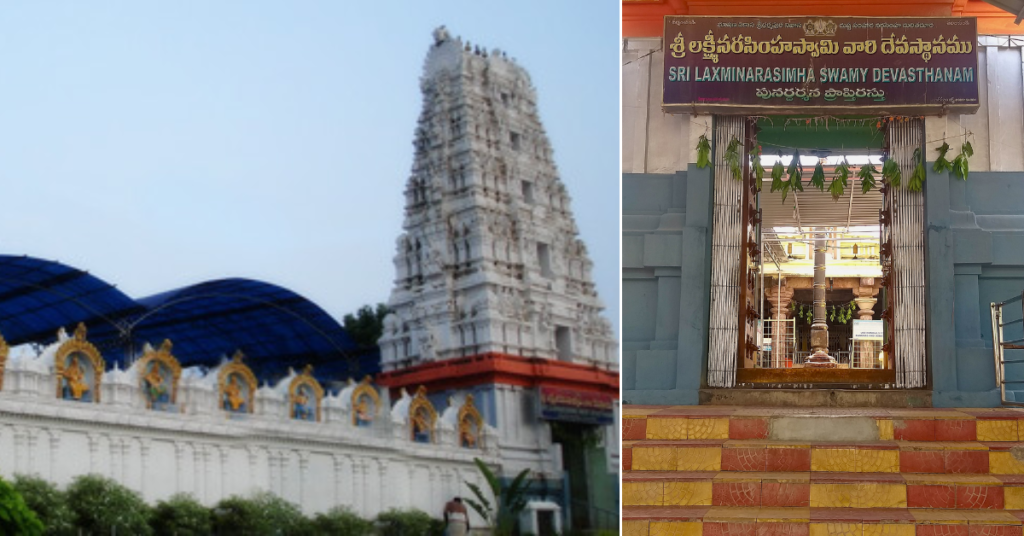
Historical Significance of Dharmapuri temple
Dharmapuri, an ancient city with deep historical roots, is mentioned in several epics and literary works. In ancient scriptures like the Skandha Purana and Brahmanda Purana, it is referred to as ‘Dharmapura’. The city’s significance dates back to the Buddhist era when it was known as ‘Dharmaram’ in the Dekkala Banda inscription of the Rashtrakutas. It also appears in the writings of Ekamranatha from the Kakatiya period, a powerful dynasty that ruled large parts of the Deccan from 950 CE to 1323 CE.
Historically, Dharmapuri was under the rule of Hindu kings like the Badami Chalukyas, Rashtrakutas, and the Recharla Velmas. It was also an important center for both Jainism and Buddhism. The intricate sculptures of the Chalukya period are seen in the Ramalingeshwara Swamy Temple, with carvings that depict stories from the Mahabharata and Ramayana.
The temple, initially built in 1018 AD, faced destruction between 1422 and 1436 AD by Muslim rulers but was rebuilt in the 17th century. Despite facing challenges during the reign of Aurangzeb, the temple still stands, preserving its historic beauty.
Also Read: Molangur Fort: Exclusive Kakatiya & Mughal History of Karimnagar
The Itihasa Behind Dharmapuri temple
According to legend, Lord Vishnu took the form of Narasimha to defeat the demon king Hiranyakashyap. Even after the demon was slain, Lord Narasimha’s rage didn’t subside. To calm him, Devas, Prahalada, and sages prayed fervently. In response, Lord Narasimha meditated at this location in the Yoga Mudra posture. King Dharma Varma, a devoted follower of Vishnu, later built the temple in honor of this divine event.
Architectural Marvel of Dharmapuri
Design and Structure
The Dharmapuri Lakshmi Narasimha Swamy Temple showcases exemplary South Indian temple architecture. The temple complex features a grand entrance with intricately carved gopurams (gateway towers). Which are adorned with sculptures of various deities and mythological figures. The main sanctum houses the idol of Lord Narasimha, depicted in his Ashtabhuja (eight-armed) form, holding various symbolic weapons.
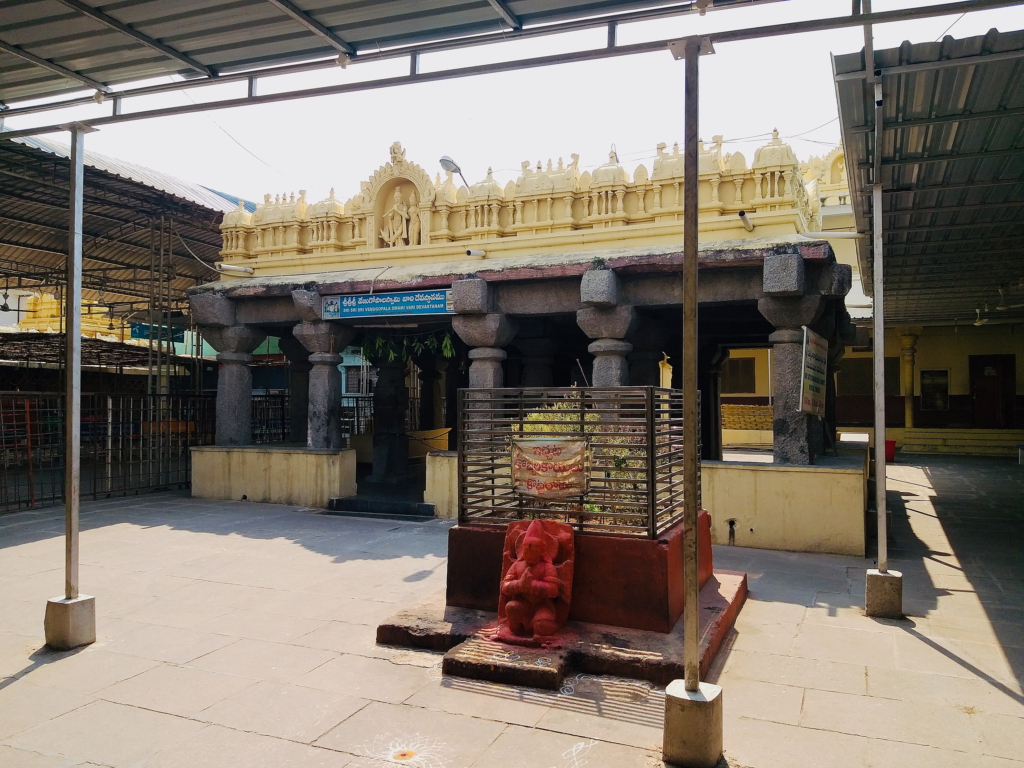
The temple’s architecture follows the Dravidian style, characterized by its towering vimanas (temple spires) and elaborate sculptures. The intricate carvings on the pillars and walls depict scenes from Hindu epics and Puranas, reflecting the artistic prowess of the period in which the temple was built.
Deities of the Dharmapuri temple
The temple houses three distinct forms of Lord Narasimha, each representing a different aspect of the deity’s divine nature:
- Seated Narasimha: This form of Lord Narasimha is depicted in a natural seated posture. It symbolizes calm and composed divinity, reflecting the serene and benevolent aspect of the deity.
- Ugra Narasimha: The second form is the fierce Ugra Narasimha, representing the deity’s wrathful aspect when he vanquished the demon Hiranyakashipu. This form is characterized by its intense expression and dynamic posture, emphasizing the deity’s role as a protector against evil forces.
- Saumya Narasimha: The third form is the peaceful Saumya avatar, akin to the form of Lord Balaji at Tirupati. This representation embodies the gentle and compassionate nature of Lord Narasimha, offering solace and blessings to devotees.
Additional Shrines
In addition to the central Narasimha deities, the temple complex features several other important shrines
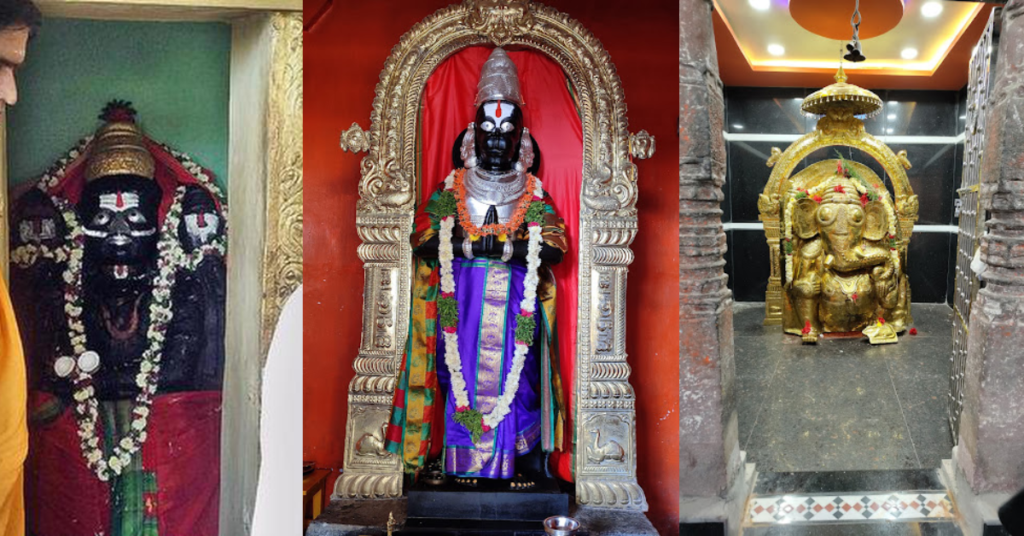
- Sri Venugopal Shrine: A small temple dedicated to Sri Venugopal, where Lord Krishna is worshipped along with his consorts, Rukmini and Satyabhama. This shrine highlights the temple’s connection to various aspects of Vishnu’s incarnations and his divine consorts.
- The idol of Yama Dharmaraja: At the entrance of the temple stands a significant idol of Yama Dharmaraja, the lord of Dharma and justice. Devotees traditionally offer their first prayers to Yama Dharmaraja upon entering the temple, seeking his blessings for righteousness and guidance.
- Lord Aanjaney Swamy: The temple also honors Lord Aanjaney Swamy (Hanuman), regarded as the Kshetra Swamy or guardian deity of the region. Devotees often pray to him for strength, protection, and devotion.
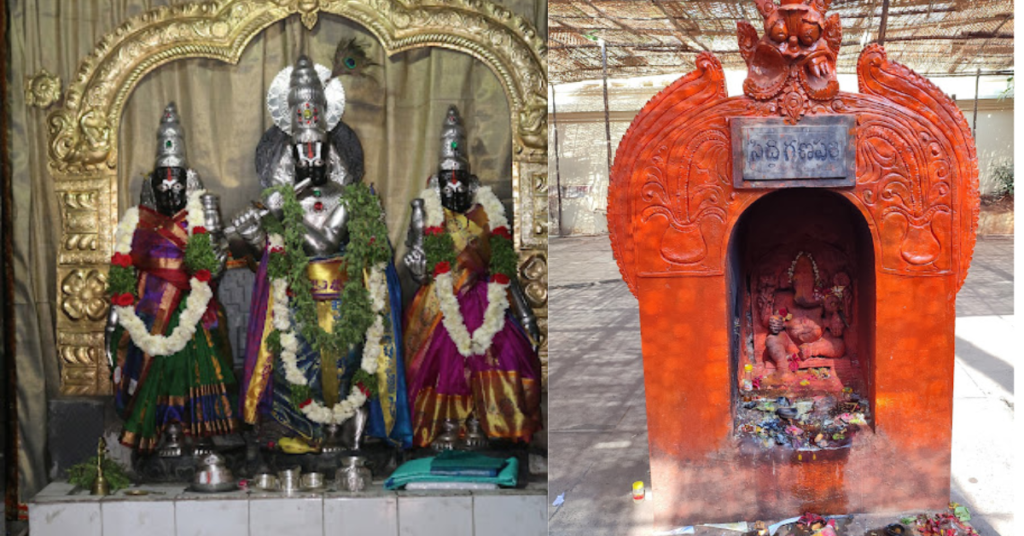
Also Read: A powerful god of Kaleshwaram: Muktheshwara Swamy
Rituals and Practices
The Dharmapuri Lakshmi Narasimha Swamy Temple follows a set of unique rituals and practices:
- Offering Prayers to Yama Dharmaraja: Upon arriving at the temple, devotees first offer their prayers to Yama Dharmaraja, acknowledging his role as the guardian of Dharma. This practice underscores the importance of justice and moral integrity in the temple’s spiritual ethos.
- Worship of Lord Aanjaney Swamy: After paying respects to Yama Dharmaraja, devotees turn to Lord Aanjaney Swamy. This act symbolizes seeking strength and devotion, with Hanuman being revered as a symbol of unwavering faith and dedication.
- Main Worship and Offerings: Devotees then proceed to worship the various forms of Lord Narasimha. Each form has its own set of rituals, including special offerings and prayers. The Ugra Narasimha form, for instance, is often the focus of intense devotional practices aimed at overcoming difficulties and seeking protection.
Festivals and Celebrations at Dharmapuri temple
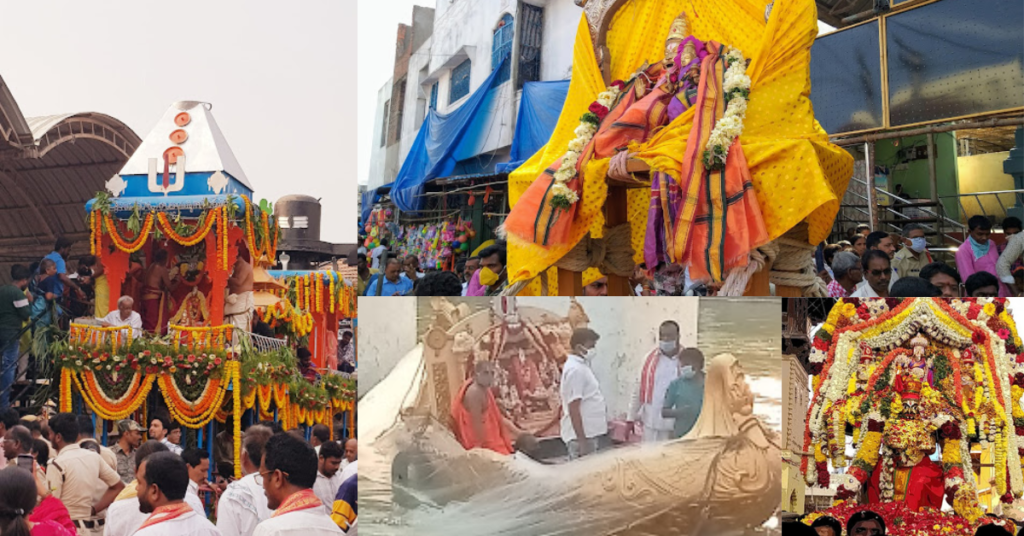
Brahmotsavam:
The Brahmotsavam is the grand annual festival of the Dharmapuri Lakshmi Narasimha Swamy Temple, typically celebrated in March–April. This festival spans several days and involves a series of rituals, processions, and cultural events. Devotees from various regions flock to the temple to participate in the celebrations, which include:
Narasimha Jayanti
Narasimha Jayanti, the celebration of Lord Narasimha’s appearance, is another significant festival held in the temple. This festival occurs on the fourth day of the bright half of the month of Vaishakha (April-May).
Connection with the Godavari River
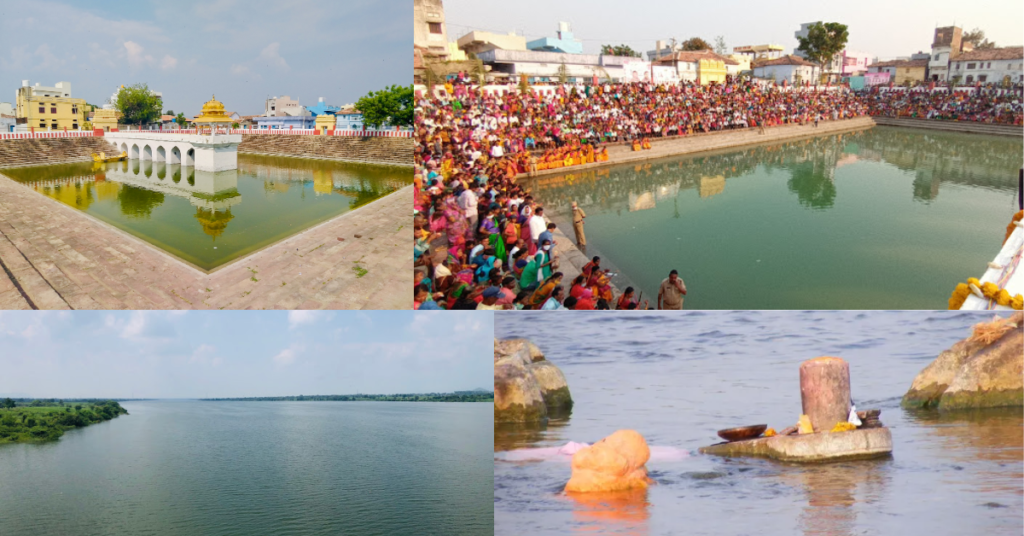
The Dharmapuri Lakshmi Narasimha Swamy Temple’s location on the banks of the Godavari River adds to its sacred significance. The river is one of the holiest in India, and its proximity to the temple enhances its spiritual importance. Devotees often take a ritual bath in the river before entering the temple, believing it purifies them and prepares them for worship.
Temple Timings
The Dharmapuri Lakshmi Narasimha Swamy Temple is open to devotees throughout the week. The daily schedule typically includes:
- Morning Puja: 6:00 AM – 8:00 AM
- Afternoon Puja: 12:00 PM – 1:00 PM
- Evening Puja: 6:00 PM – 8:00 PM
The temple is closed for a short period between the afternoon and evening pujas. Special timings may apply during festivals and significant religious events.
How to Reach the Temple
By Road
Dharmapuri is well-connected by road, with regular bus services and private vehicles available from major cities like Hyderabad, Jagtial, and Karimnagar. The journey offers scenic views of the Telangana countryside and the Godavari River.
- 230 Km from Hyderabad
- 70 Km from Karimnagar
- 30 Km from Jagityal
By Train
The nearest railway station to Dharmapuri is at Jagtial, approximately 28 kilometers away. From the railway station, one can take a taxi or local transport to reach the temple.
- Mancheryal Railway Station 40 Km
- Nizamabad Railway Station 130 Km
- Warangal Railway Station 150 Km
By Air
The nearest airport is Rajiv Gandhi International Airport in Hyderabad, around 225 kilometers from Dharmapuri. From the airport, one can travel by road to reach the temple.
Conclusion
The Dharmapuri Lakshmi Narasimha Swamy Temple is a timeless beacon of devotion, history, and cultural heritage. Its rich historical background, architectural splendor, and spiritual significance make it a cherished destination for pilgrims and history enthusiasts alike. The temple’s vibrant festivals, unique rituals, and the divine presence of its deities continue to inspire and uplift those who seek solace and blessings. A visit to this sacred shrine is not merely a spiritual journey but an immersion into the depths of South Indian cultural and religious traditions.
Frequently Asked Questions(FAQs)
A: It is an ancient South Indian temple dedicated to Lord Narasimha, located in Dharmapuri, Telangana.
A: Dharmapuri has deep historical roots, mentioned in ancient scriptures and inscriptions, and was significant during the Buddhist, Jain, and Hindu eras.
A: The temple worships three forms of Lord Narasimha: Seated Narasimha, Ugra Narasimha, and Saumya Narasimha.
A: Devotees offer their first prayers to Yama Dharmaraja, the lord of Dharma, upon entering the temple.
A: Narasimha Jayanti, celebrated in April-May, marks the appearance of Lord Narasimha and is a significant festival at the temple.
A: The temple is accessible by road, train, and air, with the nearest major city being Hyderabad, approximately 230 kilometers away.

